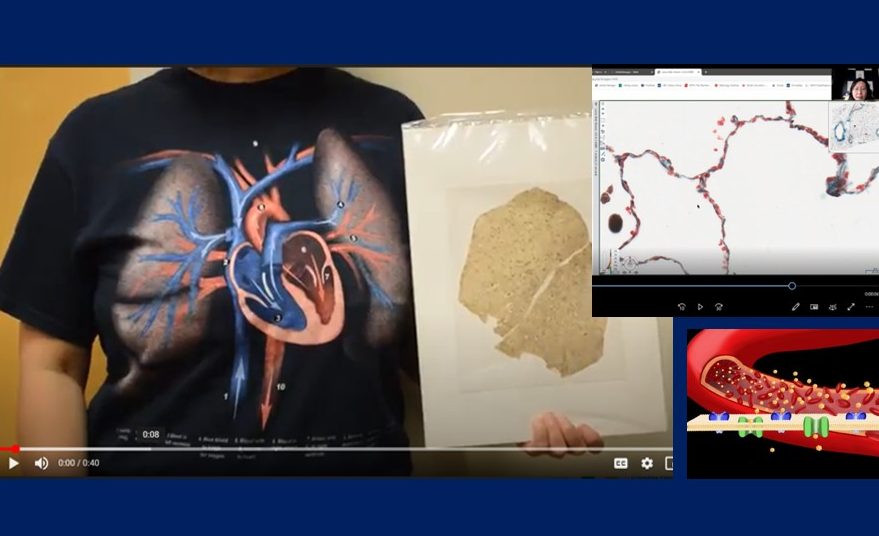Working from home during the pandemic was challenging for energetic and outgoing Basic Health Sciences faculty Jen Kong. But boredom turned to frustration when she repeatedly witnessed viral headlines and social media posts that contained so much health disinformation.

“I think everyone should learn how their body works,” explains Jen. “That helps them guard against misinformation, and be better able to understand what a symptom might represent, what causes disease, and how it’s likely to play out.”
Jen cites the challenge of competing with what she calls “Dr. Google”
“The top hit in your health-related web search might not be from the most reliable of sources,” she emphasizes.
Unfortunately, it’s very hard to judge legitimacy of statements if we don’t know much about the topic being discussed.
The desire to make vetted health information easily accessible to everyone drove Jen to a vast new project: building an interdisciplinary and inter-institutional open-source multimedia pathology resource.
“It’s an uphill battle fighting Dr. Google! This is my part in fighting misinformation.” -Jen Kong, BCIT Basic Health Sciences Faculty
Interdisciplinary, multimedia, and accessible to all
Having taught pathology for years, with access to resources like the University of British Columbia (UBC) David Hardwick Pathology Learning Centre (DHPLC), Jen felt it was unfair that such rich information wasn’t more widely available. She harnessed her network of multiple medical professionals, from immunology to cardiac science, and pitched the idea to co-author Helen Dyck of UBC’s Pathology department to create a holistic resource that would be free. Jen also received financial support from a BCIT Open Education Resource Development Grant.
The resulting Pathology: From the Tissue Level to Clinical Manifestations and Inter-professional Care was created primarily for first year post-secondary students, and focuses on the science behind disease. But anyone can use it and learn from it.
Basic Health Science faculty, chapter author, and project collaborator Simon Duffy explains: “the specimens from the DHPLC, as well as interviews with health science professionals, allows both learners and educators to connect knowledge fundamentals with real-world application.”
Interinstitutional participation so far includes UBC Pathology, BCIT School of Computing and Academic Studies, BCIT School of Health Sciences, BCIT Interprofessional Education (IPE), BCIT Library, UBC Okanagan, and Capilano University Kinesiology.
“When I first imagined this I wanted it to level the playing field,” says Jen. “So everyone entering a program could get the basics of pathology. Then their program, from medical laboratory science to kinesiology, can layer specifics on top of this foundation.”
Each disease begins with a review of normal tissue, followed by the changes the disease has on the tissue, organ, and function. Videos and photos of specimens illustrate every topic, with video lessons guiding viewers on the observable pathological changes.
“In histology – the study of tissues – traditional resources include an individual still photo,” according to Jen. But videos of cells are able to actually mimic what a health care professional would really need to look at when reviewing something like a biopsy. “They’re going to be applying a dynamic interactive skill, looking at a whole range of cells and angles. It’s something you can’t passively memorize.”
“The inclusion of videos, professional interviews, and interactive animation, makes this a far more engaging resource than a traditional textbook,” adds Simon.
Interprofessional collaboration and diverse perspectives
Pathology highlights the interprofessional collaboration between health care providers.
“Healthcare is a team endeavour,” explains Connie Evans, BCIT IPE faculty. “This resource provides insights not only into the common diseases, their pathophysiology and clinical manifestations, but also introduces readers to the health care professionals and patients and families who will work together as interprofessional teams to ensure the best outcomes for patients.”
And while a traditional textbook might mention a profession, this one offers a video of that professional describing how they would work with this content in their job. Many of the engaging, interactive elements are made by students for students, another unique feature.
Some lessons even include first-hand narratives of the patient experience, like the chapter on diabetes which features much loved BCIT staff member Sally McKinstry who passed away last year. Sally and her family discussed living with diabetes, and going through a double transplant, with Basic Health Science faculty David Kojwang and Raine Gilman. It helps students gain a holistic approach, and a deeper understanding of the patient’s perspective.
International reach
Pathology is already gaining international attention, with inquiries about using the chapters coming in from as far as Australia. Jen hopes the project will continue to inspire more collaboration across campuses, institutions, and even continents.
“It’s an uphill battle fighting Dr. Google!” Jen laments. “This is my part in fighting misinformation.”

Kudos to all involved! Knowledge is power and what better way to share it with others!